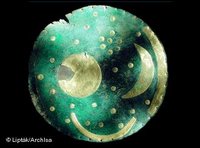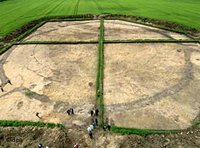Bronze Age Sky Disc Deciphered

A group of German scientists has deciphered the meaning of one of the most spectacular archeological discoveries in recent years: The mystery-shrouded sky disc of Nebra was used as an advanced astronomical clock.
The purpose of the 3,600 year-old sky disc of Nebra, which caused a world-wide sensation when it was brought to the attention of the German public in 2002, is no longer a matter of speculation. A group of German scholars who studied this archaeological gem has discovered evidence which suggests that the disc was used as a complex astronomical clock for the harmonization of solar and lunar calendars. "This is a clear expansion of what we knew about the meaning and function of the sky disc," said archeologist Harald Meller.
A thirteenth month?
The sky disc of Nebra was not all moonshine. Unlike the solar calendar, which indicates the position of the earth as it revolves around the sun, the lunar calendar is based on the phases of the moon. A lunar year is eleven days shorter than the solar year because 12 synodic months, or 12 returns of the moon to the new phase, take only 354 days. The sky disc of Nebra was used to determine if and when a thirteenth month -- the so-called intercalary month -- should be added to a lunar year to keep the lunar calendar in sync with the seasons. "The functioning of this clock was probably known to a very small group of people," Meller said.
Bronze Age science
The 32-centimeter-wide (seven-inch) bronze disc with gold-leaf appliqués representing the sun, the moon, and the stars is the oldest visual representation of the cosmos known to date. A cluster of seven dots has previously been interpreted as the Pleiades constellation as it appeared 3,600 years ago. The explanation of the disc's purpose sheds new light on the astronomical knowledge and abilities of the Bronze Age people, who used a combination of solar and lunar calendars as important indicators for agricultural seasons and passage of time.
"The sensation lies in the fact that the Bronze Age people managed to harmonize the solar and lunar years. We never thought they would have managed that," Meller said.
According to astronomer Wolfhard Schlosser of the Rurh University at Bochum, the Bronze Age sky gazers already knew what the Babylonians would describe only a thousand years later.
"Whether this was a local discovery, or whether the knowledge came from afar, is still not clear," Schlosser said.
From Saxony-Anhalt to Babylon
The sky disc of Nebra was found near Europe's oldest observatory in Goseck. Ever since the disc was discovered, archaeologists and astronomers have been
 puzzled by the shape of the moon as it appears on the disc. "I wanted to explain the thickness of the crescent on the sky disc of Nebra because it is not a new moon phase," said Hamburg astronomer Ralph Hansen.
puzzled by the shape of the moon as it appears on the disc. "I wanted to explain the thickness of the crescent on the sky disc of Nebra because it is not a new moon phase," said Hamburg astronomer Ralph Hansen.In his quest to explain why the Nebra astronomers created a sky map with a four or five days old moon on it, Hansen consulted the "Mul-Apin" collection of Babylonian documents from the 7th and 6th centuries B.C.
These cuneiform writings represent, according to Hansen, a compendium of "astronomic knowledge from the earliest times." They also contain a calculation rule for the crescent that looks strikingly similar to the one from Nebra. According to the ancient Babylonian rule, a thirteenth month should only be added to the lunar calendar only when one sees the constellation of the moon and the Pleiades exactly as they appear on the Nebra sky disc.
For the rest of this very cool story, goto Deutsche Welle


0 Comments:
Post a Comment
<< Home